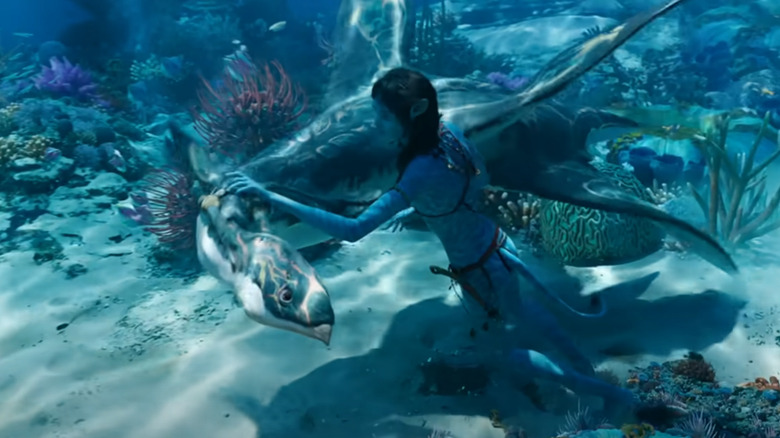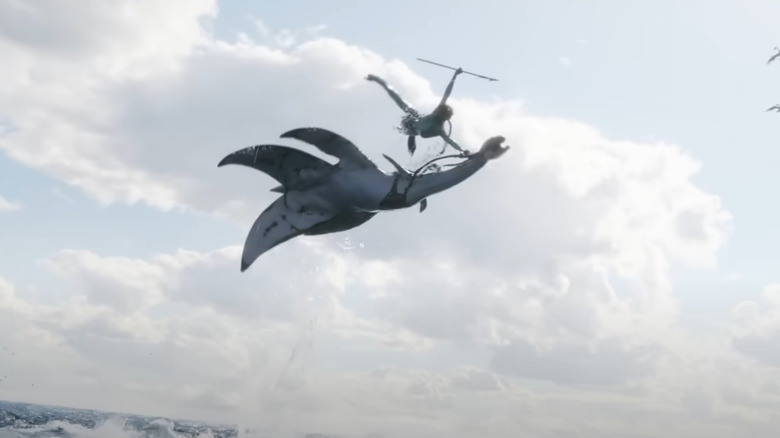James Cameron Stuck People On Four-Jet Propulsion Machines In The Ocean For Avatar 2
James Cameron is a legendary director and creator who has straddled historical epics and amazing science-fiction endeavors that raise the bar for filmmakers. Originally earning his claim to fame with 1984's "Terminator," Cameron went on to craft such epics like "Titanic," "Terminator 2: Judgment Day," "Aliens," "The Abyss," and "True Lies."
Of course, these days, Cameron is the talk of the town for his movie "Avatar," which is one of the most profitable movies of all time. Much like the Unobtainium featured in the aforementioned movie, "Avatar" has now been mined as a franchise, which may go for several installments.
Whether or not viewers get a full-blooded franchise depends on the reception of "Avatar: The Way of Water." This brand new sequel comes several years after the first film and picks up the story of Jake Sully (Sam Worthington) and Neytiri (Zoe Saldaña). Having saved the Na'vi by rallying together various tribes, Jake and Neytiri are able to defeat the human mining operations, and "Avatar" ends with the "sky people" being sent back to Earth. However, "The Way of Water" shows what transpired after the events of the first movie, and instead of taking to the skies, the film, as its name may suggest, takes place in and around water. Considering Cameron's previous movies of "Titanic" and "The Abyss," the director certainly has a predilection for watery environments.
Cameron had to develop new technology once again for Avatar: The Way of Water
Another aspect of James Cameron's directorial style is that he creates scenes requiring new technology to be invented. Deep Sea Challenge reported that in 2001, Cameron developed a whole slew of new technology made specifically for exploring the real-life wreckage of the Titanic, creating brand new fiber-spooling remotely operated mini vehicles, deep-ocean lighting, and photographic technology. In other words, Cameron has no qualms about developing new devices and techniques in order to obtain exactly what he is looking for. As noted by our sibling site /Film, Cameron once spoke about how 3D technology, which he used extensively in "Avatar," isn't going anywhere, clarifying that "Avatar" won best cinematography with a 3D camera – the first movie to do so. Cameron then added that 3D movies weren't going anywhere and likened the technology to when color film first became available.
Of course, with "Avatar: The Way of Water," Cameron has yet another set of challenges on his hands. The first movie extensively used motion capture suits, but how does one utilize the same technology when it comes to underwater scenes? Speaking with EW, Cameron explained that in the early stages of "Avatar 2," they had to develop a new means of capturing underwater scenes. He added, "My colleagues within the production really lobbied heavily for us to do it 'dry for wet,' hanging people on wires. I said, 'It's not going to work. It's not going to look real.' I even let them run a test, where we captured dry for wet, and then we captured in water, a crude level of our in-water capture. And it wasn't even close."
Cameron crafted equipment that could swim and fly in real life
Considering that Cameron developed an entirely new way of filming underwater scenes involving motion capture suits, with the "Avatar" cast being trained to hold their breath for long tracks of time, it would make sense that wasn't the only technology needed to bring "The Way of Water" to life. With fantastic beasts that can swim beneath the waves and take to the skies, yet another piece of equipment would be required. As such, Cameron set his crew to craft a platform that would allow the new semi-aquatic and semi-aerial creatures to come to life.
In an interview with BBC Radio 1 on YouTube, Cameron explained how they were able to create the amazing scenes in "Avatar: The Way of Water" with the flying aquatic animals. He said, "We also went out into the ocean with functional mock-ups of the creatures that could actually fly and dive and do hydrobatics underwater and all the things that they do in the movie. It sounds impossible, but we did it with water jet propulsion. So I don't know if you've ever seen these at resorts — they have these guys that go up in these platforms, and they fly around 25 feet up, and they do flips and things like that. We took that technology, developed it further, and made a four-jet version of a skim-wing, and the skim-wing could go 20 miles an hour underwater, pop out of the water, fly around and then dive back in."
That means when one sees these scenes in "Avatar: The Way of Water," they aren't entirely CGI creations, and that Cameron helped craft a flying and diving vehicle in order to bring his authentic vision to audiences.


